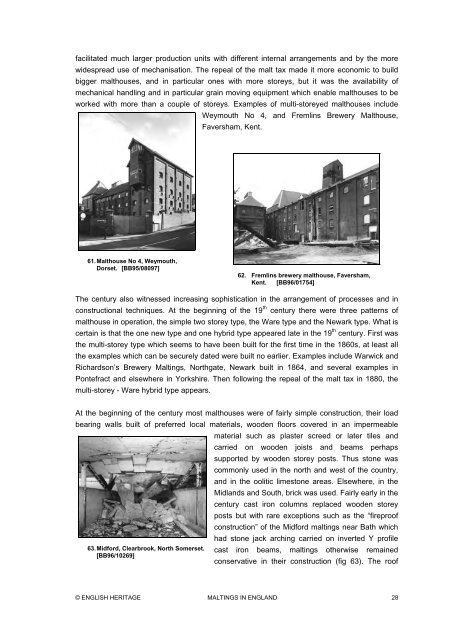Maltings in England - English Heritage
Maltings in England - English Heritage
Maltings in England - English Heritage
Create successful ePaper yourself
Turn your PDF publications into a flip-book with our unique Google optimized e-Paper software.
facilitated much larger production units with different <strong>in</strong>ternal arrangements and by the more<br />
widespread use of mechanisation. The repeal of the malt tax made it more economic to build<br />
bigger malthouses, and <strong>in</strong> particular ones with more storeys, but it was the availability of<br />
mechanical handl<strong>in</strong>g and <strong>in</strong> particular gra<strong>in</strong> mov<strong>in</strong>g equipment which enable malthouses to be<br />
worked with more than a couple of storeys. Examples of multi-storeyed malthouses <strong>in</strong>clude<br />
Weymouth No 4, and Freml<strong>in</strong>s Brewery Malthouse,<br />
Faversham, Kent.<br />
61. Malthouse No 4, Weymouth,<br />
Dorset. [BB95/08097]<br />
62. Freml<strong>in</strong>s brewery malthouse, Faversham,<br />
Kent. [BB96/01754]<br />
The century also witnessed <strong>in</strong>creas<strong>in</strong>g sophistication <strong>in</strong> the arrangement of processes and <strong>in</strong><br />
constructional techniques. At the beg<strong>in</strong>n<strong>in</strong>g of the 19 th century there were three patterns of<br />
malthouse <strong>in</strong> operation, the simple two storey type, the Ware type and the Newark type. What is<br />
certa<strong>in</strong> is that the one new type and one hybrid type appeared late <strong>in</strong> the 19 th century. First was<br />
the multi-storey type which seems to have been built for the first time <strong>in</strong> the 1860s, at least all<br />
the examples which can be securely dated were built no earlier. Examples <strong>in</strong>clude Warwick and<br />
Richardson’s Brewery <strong>Malt<strong>in</strong>gs</strong>, Northgate, Newark built <strong>in</strong> 1864, and several examples <strong>in</strong><br />
Pontefract and elsewhere <strong>in</strong> Yorkshire. Then follow<strong>in</strong>g the repeal of the malt tax <strong>in</strong> 1880, the<br />
multi-storey - Ware hybrid type appears.<br />
At the beg<strong>in</strong>n<strong>in</strong>g of the century most malthouses were of fairly simple construction, their load<br />
bear<strong>in</strong>g walls built of preferred local materials, wooden floors covered <strong>in</strong> an impermeable<br />
material such as plaster screed or later tiles and<br />
carried on wooden joists and beams perhaps<br />
supported by wooden storey posts. Thus stone was<br />
commonly used <strong>in</strong> the north and west of the country,<br />
and <strong>in</strong> the oolitic limestone areas. Elsewhere, <strong>in</strong> the<br />
Midlands and South, brick was used. Fairly early <strong>in</strong> the<br />
century cast iron columns replaced wooden storey<br />
posts but with rare exceptions such as the “fireproof<br />
construction” of the Midford malt<strong>in</strong>gs near Bath which<br />
had stone jack arch<strong>in</strong>g carried on <strong>in</strong>verted Y profile<br />
63. Midford, Clearbrook, North Somerset. cast iron beams, malt<strong>in</strong>gs otherwise rema<strong>in</strong>ed<br />
[BB96/10269]<br />
conservative <strong>in</strong> their construction (fig 63). The roof<br />
© ENGLISH HERITAGE MALTINGS IN ENGLAND 28
















